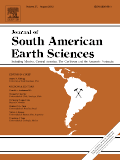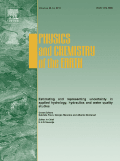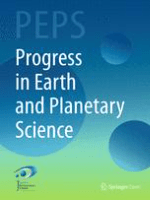
Vietnam Journal of Earth Sciences
Scope & Guideline
Innovating Solutions for a Sustainable Planet
Introduction
Aims and Scopes
- Geological and Geochemical Research:
Focuses on the study of geological formations, mineral resources, and geochemical processes, particularly in Southeast Asia, providing insights into the region's tectonic history and resource potential. - Environmental and Ecological Studies:
Explores the interactions between natural systems and human activities, emphasizing the assessment of environmental impacts, water quality, and biodiversity conservation in various ecosystems. - Remote Sensing and Geospatial Analysis:
Utilizes advanced remote sensing technologies and geospatial analysis to monitor environmental changes, land use dynamics, and natural disasters, contributing to sustainable resource management. - Hydrology and Water Resource Management:
Investigates hydrological processes, water quality, and water resource management strategies, particularly in the context of climate change and its effects on water availability. - Natural Hazards and Disaster Risk Reduction:
Addresses the assessment and mitigation of natural hazards such as earthquakes, landslides, and floods, with a focus on developing predictive models and risk reduction strategies. - Machine Learning and Data Science Applications:
Incorporates machine learning techniques to enhance predictive modeling and data analysis in various domains of earth sciences, facilitating better decision-making.
Trending and Emerging
- Machine Learning and Artificial Intelligence Applications:
There is a growing trend in the application of machine learning and AI for predictive modeling in various disciplines, including hydrology, geology, and environmental monitoring, indicating a shift towards data-driven research. - Climate Change Impact Studies:
Research focusing on the impacts of climate change, particularly concerning water resources, biodiversity, and natural disasters, has gained prominence as the urgency of climate-related issues increases. - Remote Sensing Innovations:
The use of cutting-edge remote sensing technologies for environmental monitoring, land cover change analysis, and disaster management is rapidly emerging as a key research area in the journal. - Sustainable Resource Management:
There is an increasing emphasis on sustainable practices in resource management, including studies on groundwater management, soil conservation, and eco-friendly agricultural practices. - Natural Disaster Mitigation Strategies:
Research on effective strategies for natural disaster risk reduction, including modeling and preparedness planning, has become a critical area of focus amid growing concerns over natural hazards.
Declining or Waning
- Traditional Geological Surveys:
There has been a noticeable shift away from conventional geological surveys towards more innovative and technology-driven methodologies, such as remote sensing and machine learning applications. - General Environmental Studies:
Research focusing on broad environmental studies without specific applications or localized case studies appears to be waning as more targeted and impactful research emerges. - Paleoclimate Studies:
While still relevant, the frequency of publications specifically dedicated to paleoclimate studies has diminished, potentially overshadowed by more immediate climate change impacts and contemporary environmental issues. - Basic Geochemistry:
The focus on fundamental geochemical studies is declining as the journal pivots towards applied geochemistry that addresses current environmental challenges and resource management. - General Biodiversity Assessments:
The journal is moving away from general assessments of biodiversity towards more specific studies that directly relate to conservation strategies and the impacts of climate change.
Similar Journals

Earth and Space Science
Navigating the Nexus of Earth Sciences and Environmental Insights.Earth and Space Science, published by the American Geophysical Union, is a distinguished open-access journal that has profoundly impacted the realms of earth and planetary sciences as well as environmental science since its inception in 2014. With impressive rankings, including Q1 in both Earth and Planetary Sciences and Environmental Science for 2023, this journal ranks 38th out of 195 in the general Earth and planetary sciences category and 51st out of 219 in environmental science, showcasing its commitment to high-quality research dissemination. The journal serves as a vital platform for researchers, professionals, and students, fostering the exploration of critical topics and advancements within these pivotal fields. With an accessible format, researchers can benefit from the rich content available, furthering their knowledge and ensuring that groundbreaking discoveries reach a broader audience. The journal's ongoing commitment to open access aligns with contemporary trends in scholarly communication, emphasizing inclusion and collaboration in tackling pressing global challenges.

JOURNAL OF SOUTH AMERICAN EARTH SCIENCES
Pioneering Research in South American Earth SciencesJOURNAL OF SOUTH AMERICAN EARTH SCIENCES is a premier interdisciplinary journal dedicated to publishing high-quality research in the fields of Earth-Surface Processes, Geology, and Paleontology, making it an essential resource for scientists and researchers focused on South American geology and its diverse geological phenomena. Published by Pergamon-Elsevier Science Ltd in the United Kingdom, this journal has been instrumental in disseminating groundbreaking studies since 1988, showcasing contributions that push the boundaries of knowledge in Earth and Planetary Sciences. With an impressive Scopus ranking—positioning it in the 74th percentile for Paleontology and 71st for Geology—this journal not only reflects robust academic quality but also its commitment to addressing critical geological challenges in South America. Researchers will appreciate its objective of advancing understanding of geological processes while providing insights into past, present, and future Earth environments. Although available through traditional subscription models, the journal's vast repository of articles enriches the academic landscape, facilitating the sharing of vital research among professionals, students, and geological practitioners.

Geofizika
Connecting Researchers to the Core of GeophysicsGeofizika, an esteemed journal published by the Andrija Mohorovičić Geophysical Institute at the University of Zagreb, presents a significant platform for research in the fields of geophysics and Earth sciences. With an Open Access model established since 1984, this journal ensures that scientific knowledge is accessible to a broad audience, encouraging collaborations and the free exchange of ideas. Geofizika has steadily evolved through its converging years from 1989 to 1999 and has been active from 2003 to the present, reflecting its commitment to advancing geophysical research. The journal has been recognized for its contributions to Earth and Planetary Sciences and has acquired respectable ranks in various categories; notably, it holds a Q4 status in Geophysics as of 2023. Researchers, professionals, and students will find Geofizika a valuable resource for the latest discoveries and methodologies in geophysics, supporting the academic community in expanding the frontiers of knowledge in these vital scientific domains.

PHYSICS AND CHEMISTRY OF THE EARTH
Innovating Research in Geophysics and PetrologyThe Physics and Chemistry of the Earth is a premier interdisciplinary journal published by Pergamon-Elsevier Science Ltd, dedicated to advancing the understanding of Earth sciences through the integration of geophysical and geochemical perspectives. With an ISSN of 1474-7065 and an E-ISSN of 1873-5193, the journal serves as a critical platform for researchers and professionals to disseminate key findings and innovative methodologies in the realms of geophysics and petrology. As of 2023, it proudly holds a Q2 ranking in both Geochemistry and Petrology and Geophysics, reflecting its robust impact in the scientific community, with Scopus rankings that position it in the top 20% and 32% of its respective categories. Notably, the journal is available in an open-access format, allowing for greater dissemination and accessibility of research contributions. With a publication history spanning from 1992 to 2024, Physics and Chemistry of the Earth stands as a vital resource for ongoing research and discovery in the Earth sciences, making it an essential read for academics and practitioners alike.

Frontiers of Earth Science
Pioneering Research for a Sustainable FutureFrontiers of Earth Science is a prominent academic journal in the field of Earth and Planetary Sciences, published by Springer. With an ISSN of 2095-0195 and an E-ISSN of 2095-0209, this journal serves as a significant platform for researchers and professionals to disseminate their findings from 2007 to 2024. It is recognized for its impactful contributions within the category of Earth and Planetary Sciences, boasting a respected Q2 ranking in 2023. With a Scopus ranking of 64 out of 195, placing it in the 67th percentile, Frontiers of Earth Science continues to drive academic dialogue and innovation. The journal is dedicated to exploring a diverse range of topics, including geology, meteorology, and environmental science, and amplifying the understanding of Earth systems through rigorous research. Located in New York, USA, this journal embraces an Open Access model, ensuring that groundbreaking research is readily available to the global scientific community, thereby enhancing its accessibility and impact.

Earth Interactions
Bridging Disciplines to Decode Earth’s ComplexitiesEarth Interactions is a prominent journal that serves as a critical platform for interdisciplinary research in the field of Earth and Planetary Sciences. Published by the American Meteorological Society, this journal has established itself as a key resource for scholars, researchers, and professionals dedicated to understanding Earth's complex systems and their interactions. With an impressive Q1 ranking in the category of Earth and Planetary Sciences for 2023, it reflects a commitment to high-quality scholarship and impactful contributions to the field. The journal, with its dedicated coverage from 2004 to 2024, encompasses a wide array of topics, providing comprehensive insights into geological, atmospheric, and environmental phenomena. Although it operates under a non-open access model, its significance is underscored by its placement in the top percentile of Scopus rankings (Rank #89/195), making it an exciting resource for those pursuing advanced studies and applications related to Earth's systems.

Frontiers in Earth Science
Exploring the Depths of Earth Science InnovationFrontiers in Earth Science is a leading open-access journal published by FRONTIERS MEDIA SA, based in Switzerland. With its ISSN N/A and E-ISSN 2296-6463, this journal has firmly established itself in the realm of Earth and Planetary Sciences, evidenced by its exceptional Q1 ranking in the 2023 category of Earth and Planetary Sciences (miscellaneous) and a solid position of Rank #66/195 in Scopus, placing it in the 66th percentile among its peers. Since its inception in 2013, Frontiers in Earth Science has embraced the open access model, promoting widespread dissemination and accessibility of research findings. The journal covers a broad scope, including areas such as geology, meteorology, oceanography, and environmental science, fostering interdisciplinary communication and advancement. Researchers, professionals, and students looking to stay at the forefront of Earth science research will find an invaluable resource in this journal, which not only curates high-quality research but also supports innovative and impactful studies that address the pressing challenges facing our planet today.

Russian Journal of Earth Sciences
Innovating research for a sustainable future.Russian Journal of Earth Sciences, published by the esteemed Geophysical Center RAS, is a pivotal resource for researchers and professionals in the field of Earth and Planetary Sciences. With an ISSN of 1681-1208 and an E-ISSN of 1681-1208, this journal has demonstrated a significant trajectory since its inception in 1998, currently converging towards its 2024 goal of disseminating innovative research. The journal holds a respectable position within the academic community, ranked Q3 in Earth and Planetary Sciences by Scopus, placing it at the 44th percentile among the most relevant journals in the field. Though it operates under a traditional access model, its commitment to advancing scientific knowledge ensures that vital research findings are available to a global audience. Located in Moscow, Russian Federation, the journal not only serves as a platform for high-quality research but also fosters a collaborative environment for scholars aiming to contribute to the understanding of our planet's geological phenomena.

Progress in Earth and Planetary Science
Catalyzing global discourse in Earth and planetary studies.Progress in Earth and Planetary Science is a premier open-access journal published by Springer, dedicated to advancing the field of Earth and planetary sciences. Since its inception in 2014, this journal has emerged as a prominent platform, achieving a Q1 ranking in the Earth and Planetary Sciences category, reflecting its high impact and rigorous peer-review process that ensures the highest quality of published research. With its broad scope encompassing diverse subfields within the Earth sciences, the journal aims to foster interdisciplinary collaboration and innovation among researchers, professionals, and students. The journal's commitment to accessibility through its open access model promotes the dissemination of knowledge globally, allowing critical research findings to be shared widely within the scientific community. Located in the United Kingdom, Progress in Earth and Planetary Science continues to play an essential role in shaping the future of Earth and planetary research from 2014 to 2024 and beyond.

Vestnik of Saint Petersburg University Earth Sciences
Connecting Ideas for Environmental StewardshipVestnik of Saint Petersburg University Earth Sciences, published by ST PETERSBURG UNIV PRESS, serves as a pivotal platform for the dissemination of innovative research within the fields of Earth Sciences, Environmental Science, Geography, and Geology. This journal, with an ISSN of 2541-9668 and an E-ISSN of 2587-585X, aims to foster scholarly communication and facilitate advancements in understanding the diverse and complex interactions within our planet's systems. Operating from the Russian Federation, the journal is unique in its commitment to an open-access model, making critical research accessible to a global audience of researchers, professionals, and students. Although currently classified in the Q4 quartile in several relevant categories, its ranking showcases the potential for growth and increased impact within the academic community. Aiming to converge ideas and findings from 2017 to 2024, the Vestnik of Saint Petersburg University Earth Sciences is dedicated to enriching the dialogue and supporting collaborative research efforts in disciplines crucial for sustainable development and environmental stewardship.